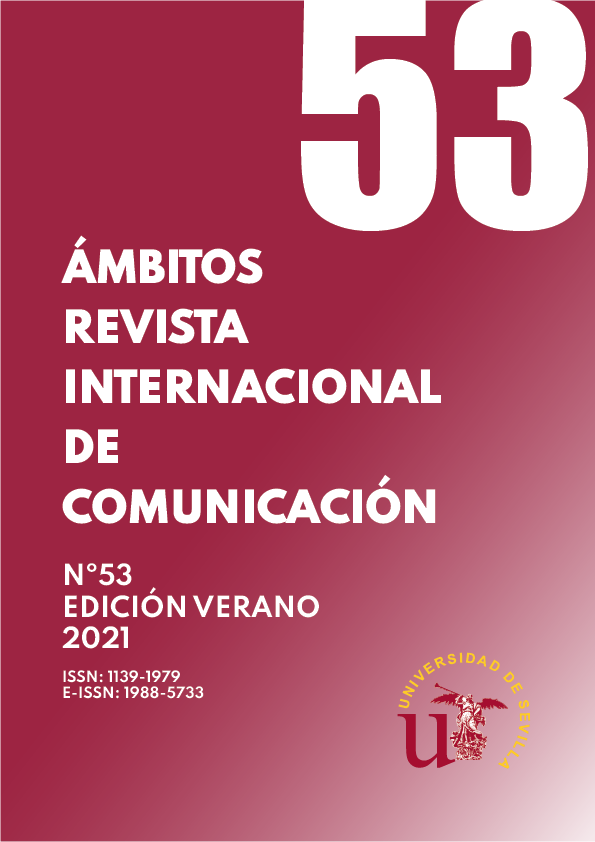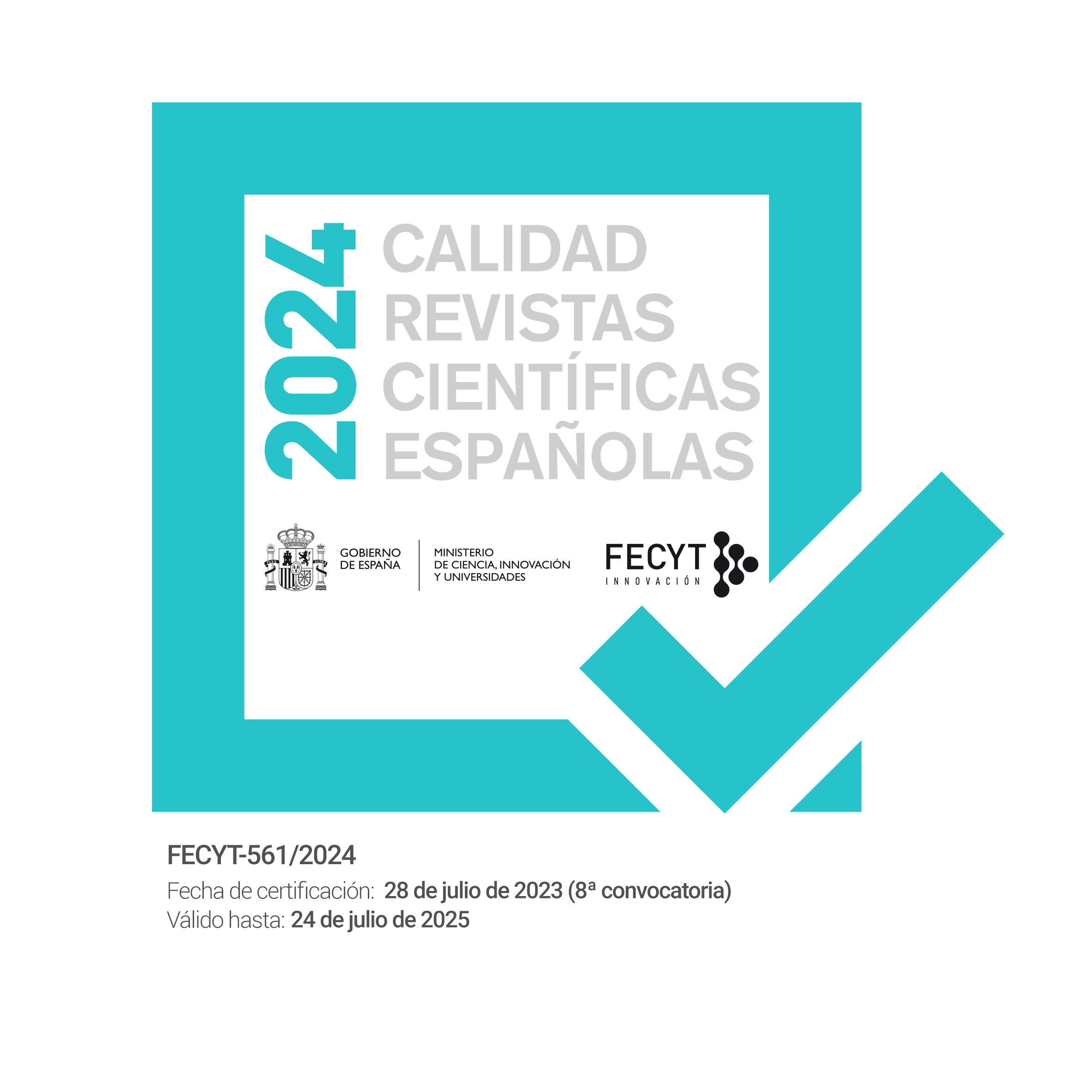O instagram e as hashtags como recurso para a recuperação da informação
DOI:
https://doi.org/10.12795/Ambitos.2021.i53.05Palabras clave:
Hashtags, Instagram, Etiquetado social, Desinformación, Viaje y turismoResumen
Investigación exploratoria y descriptiva que tiene como objetivo examinar la naturaleza de los hashtags como recurso informativo para nombrar y recuperar información de Instagram. El etiquetado se aborda como un proceso que se realiza para la nomenclatura gratuita de fotos y videos por parte de los usuarios mediante el uso de tags (etiquetas) en la red social estudiada. Insta-gram se entiende como una red social de gran popularidad, a la que cada vez más se ha adherido por la sociedad como fuente de información, pero, por otro lado, también se apunta el tema de la desinformación. Presenta los hashtags como una forma de gestión de contenidos, justificando su uso como representación de información que puede beneficiarse de las técnicas de indexación. Los procedimientos metodológicos utilizados son la investigación bibliográfica para relevar la literatura sobre el tema en bases de datos y la investigación empírica que se realiza en el entorno de Instagram con el fin de recolectar la muestra y objeto de investigación. El enfoque adoptado en el estudio es cuanti-cualitativo, en el que se examinan los hashtags de fotos y videos utilizados en treinta y tres perfiles de viajes y turismo, dando como resultado 330 publicaciones, entre fotos y videos, y 945 hashtags diferentes. Estos se identifican y examinan de acuerdo con las categorías de análisis derivadas de la literatura sobre ciencias de la información. Los resultados se presentan estadísticamente y se comentan. Se concluyó que los hashtags cumplen parcialmente la función de medio de búsqueda de información, pero la relación entre la fuente de información (fotos y videos) y su denominación a través de hashtags intuitivos presenta problemas: entre otros, inconsistencias en relación a los contenidos. Es necesario considerar la posibilidad de crear pautas para el uso de hashtags en Instagram.
Descargas
Citas
Araújo, C. A.A. (2018). O que é Ciência da Informação? KMA.
Baeza-Yates, R. & Ribeiro-Neto, B. (2011). Modern information retrieval. Addison Wesley.
Brandt, M. B. (2009). Etiquetagem e folksonomia: uma análise sob a óptica dos processos de organização e recuperação da informação na web. [Dissertação, Universidade de Brasília]. Repositório Institucional UnB. http://repositorio.unb.br/handle/10482/7057?mode=full
Brás, R. X., Brás, A. X., Brás, A. J. S. (2017). Imagem fotográfica como fonte de informação. Revista Bibliomar, 15(1/2), 113-123. http://hdl.handle.net/20.500.11959/brapci/126466
Campos, M. D. A., Gomes, H. E. (2008). Taxonomia e classificação: o princípio de categorização. DataGramaZero: Revista de Ciência da Informação, 9(4). https://doi.org/10.22478/ufpb.1981-0695.2008v3n2.5281
Carlan, E. & Bräscher, M. (2011). Sistemas de organização do conhecimento na visão da ciência da informação. Revista Ibero-Americana de Ciência da Informação, 4(2). https://brapci.inf.br/index.php/res/v/72824
Cordeiro, R. I. N. (2018). O delineamento de uma pesquisa em imagens e audiovisuais na Ciência da Informação: o “tagueamento” como quarta dimensão. Informação & Informação, 23(1), 6-30. http://dx.doi.org/10.5433/1981-8920.2018v23n1p06
Cunha, E. L. T. P. (2012). Etiquetagem de micromensagens no Twitter: uma abordagem linguística. [Dissertação, Universidade Federal de Minas Gerais]. Repositório Institucional UFMG http://hdl.handle.net/1843/ESBF-8UZJ4X
Delmazo, C. & Valente, J. C. L. (2018). Fake news nas redes sociais online: propagação e reações à desinformação em busca de cliques. Media & Jornalismo, 18(32), 155-169. https://doi.org/10.14195/2183-5462_32_11
Fernandes, R. (2019, 17 de dezembro). Instagram anuncia ferramenta para combater notícias falsas no Brasil. Techtudo. https://www.techtudo.com.br/noticias/2019/12/instagram-anuncia-ferramenta-para-combater-noticias-falsas-no-brasil.ghtml
Fragoso, S., Recuero, R., Amaral, A. (2013). Métodos de pesquisa para a internet. Sulinas.
Freire, G. H. (2006). Ciência da informação: temática, histórias e fundamentos. Perspectivas em Ciência da Informação, Belo Horizonte, 11(1), 6-19. http://portaldeperiodicos.eci.ufmg.br/index.php/pci/article/view/442
Gil Leiva, I. (2012). Aspectos conceituais da indexação. Política de indexação. (pp. 31-106). Cultura Acadêmica.
Guess, A., Nagler, J., Tucker, J. (2019) Less than you think: Prevalence and predictors of fake news dissemination on Facebook. Science Advance. 5(1) eaau4586. https://advances. sciencemag.org /content/5/1/eaau4586/tab-pdf
Hearst, M. A. (1999). The use of categories and clusters for organizing retrieval results. En Tomek Strzalkowski (Ed.), Natural language information retrieval (pp. 333-374). Springer.
Instagram, INC. (2021) Como faço para usar hashtags no Instagram?. Instagram. https://help.instagram.com/351460621611097?helpref=search&sr=1&query=hashtags&search_session_id=ab6083de3a2f780b218308407cb4c245
Karlova, N.A. & Fisher, K.E. (2013, 14 de março). A social diffusion model of misinformation and disinformation for understanding human information behaviour. Information Research, 18(1) paper 573. http://InformationR.net/ir/18-1/paper573.html
Marchiori, P. Z. Informação e conhecimento nos processos de tagging (marcação) de conteúdo colaborativo. (2012). En Maria Inês Tomael (Org.), Compartilhamento da Informação. (pp. 41-72). EDUEL.
Marwick, A., Kuo, R., Cameron, S. J., Weigel, M. (2021). Critical Disinformation Studies: A Syllabus. Center for Information, Technology, & Public Life (CITAP), University of North Carolina at Chapel Hill. https://citap.unc.edu/critical-disinfo
Morrison, P. J. (2007). Folksonomies: why are they tagging, and why do we want them to?. Bulletin of the American Society for information Science. 34(1) https://doi.org/10.1002/bult.2007.1720340105
Moura, K. F. & Mandaji, C. D. S. (2014). A relação das hashtags com as palavras de ordem presentes nas manifestações brasileiras de 2013. XV Congresso de Ciências da Comunicação da Região Sul (Intercom Sul). Universidade do Sul de Santa Catarina, Palhoça, Santa Catarina, Brasil.
Rafferty, P. (2018). Tagging. Knowledge Organization, 45(6), 500-516.
Statista. (2021). Distribution of Instagram users in Brazil as of January 2021, by age group. Statista. https://www.statista.com/statistics/866268/instagram-user-share-brazil-age/
Statista. (2021). Eading countries based on number of Instagram users as of April 2019 (in millions). Statista. https://www.statista.com/statistics/578364/ countries-with-most-instagram-users/.
Statista. (2021). Instagram - Statistics & Facts. Statista. https://www.statista.com/topics/1882 /instagram/
SXSW. (2019, 1 de abril). Keynote: Instagram Founders Kevin Systrom & Mike Krieger | SXSW 2019. [Vídeo]. Youtube. https://www.youtube.com/watch?v=zc0Wt6WrjUg&ab_channel=SXSW
Systrom, K. (2018, 20 de junho) Welcome to IGTV. Instagram. https://about.instagram.com/pt-br/blog/announcements/welcome-to-igtv
Terra, J. C., Schouerl, R., Vogel, M. J., Franco, C. (1998). Taxonomia: elemento fundamental para a gestão do conhecimento. Biblioteca Terra Fórum Consultores. http://paginapessoal.utfpr.edu.br/ mansano/arquivos/taxonomia.pdf/view
Wal, T. V. (2007, 2 de fevereiro). Folksonomy. Vanderwal.net. http://www.vanderwal.net/folksonomy. html
Descargas
Publicado
Cómo citar
Número
Sección
Licencia
Derechos de autor 2021 Thaís Guimarães, Rosa Inês de Novais Cordeiro

Esta obra está bajo una licencia internacional Creative Commons Atribución-NoComercial-CompartirIgual 4.0.
Ámbitos. Revista Internacional de Comunicación es una revista de acceso abierto, lo que significa que todo su contenido está disponible gratuitamente para el usuario o su institución. Los usuarios pueden leer, descargar, copiar, distribuir, imprimir, buscar o enlazar con el texto completo de los artículos, o utilizarlos para cualquier otro fin lícito, sin solicitar permiso previo al editor o al autor. Esta definición de acceso abierto se ajusta a la Iniciativa de Acceso Abierto de Budapest (BOAI).

A menos que se indique lo contrario, todo el contenido de la edición electrónica se distribuye bajo una " licencia internacional Creative Commons Attribution-NonCommercial-ShareAlike 4.0 ". Puede consultar la versión informativa y el texto legal de la licencia aquí. Esto debe indicarse expresamente de esta manera cuando sea necesario.
En caso de aceptación del manuscrito, los autores ceden los derechos de la obra para su publicación a Ámbitos. Revista Internacional de Comunicación bajo el contrato de licencia Reconocimiento-NoComercial-CompartirIgual 4.0 Internacional (CC BY-NC-SA 4.0). Los autores conservan los derechos de autor y terceros están autorizados a copiar, distribuir y hacer uso de la obra, siempre que cumplan con los términos y condiciones establecidos en la licencia.
- Citar la autoría y la fuente original de publicación (revista, editorial y URL de la obra).
- No los utilice con fines comerciales.
- Si remezcla, transforma o crea a partir del material, debe publicar sus contribuciones bajo la misma licencia que el original.
Se puede encontrar más información en https://creativecommons.org/licenses/by-nc-sa/4.0/deed.es



















